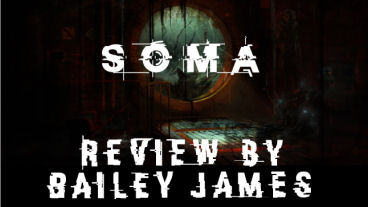
SOMA Review
A game with staying power, both in the nightmares it will cause and the lingering questions it demands players to confront







Genre: Horror Adventure
Release date: September 21, 2015
Any horror-loving PC gamer who devoured Amnesia: The Dark Descent should be excited about SOMA. Frictional Games, which is renowned for its immersive and chilling titles, has created a game that mixes a strong dose of the perfectly calculated ambient terror of Amnesia with weighty questions about the nature of existence and what it means to be alive. The result is a game with staying power, both in the nightmares it will cause and the lingering questions it demands players to confront.
The story begins with a car crash and a brain injury, though this setup is merely a vehicle for the premise that follows. After undergoing a brain scan meant to study his critical injuries, Simon Jarrett, our protagonist, wakes up a hundred years later in an underwater facility called Pathos-II with no idea how he got there. As he begins to explore, the reality of the situation unfolds by degrees: ominous bloody streaks mar the walls, unfamiliar technology hums in the claustrophobic rooms and Pathos-II is in a state of serious disrepair. Cue the noisy, jumpy, flickery horror. The short version is that you’ll have to make your way through the underwater buildings while avoiding aggressive and frightening mutations to survive.
If you don’t want any part of SOMA spoiled for you, turn back now, because it’s impossible to talk about how this game works without revealing the thematic hinges upon which it swings. One of the first things you’ll notice as you explore the facility is that there’s a dearth of humans but a lot of irate and anthropomorphic robots. The computers, data logs and “black boxes” that record the final moments of a corpse’s life tell the story of a hostile takeover by the WAU, an artificially intelligent substance that has mutated to corrupt humans and machines alike, making them into hostile enemies for the player to avoid. The black, tarlike WAU is everywhere, and Simon learns early on that he can touch it to regain health if he is injured.
But why? It doesn’t take long for the reason to become clear. One early stroke of brilliance on SOMA’s part is that it manipulates the player’s expectation of exceptionalism. We expect our games’ protagonists to be chosen saviors with unique talents, so the fact that my character seems to be the only human around didn’t faze me at all. But it’s a breathtaking moment when Simon looks down at his hands to discover mechanical fingers wiggling at his command. He, too, is only part human—his consciousness has been uploaded into a suit with another person’s dead body still in it, and the original, corporeal Simon Jarrett perished many, many years ago. The only way he can ensure the continued survival of his “brain scan” is to transmit it to the ARK, a supercomputer stored somewhere in Pathos-II, and fire it into space.
At its root, the true horror of SOMA lies in the philosophical questions of what it means to be a person and how much our identities are tied to our physicality (the word “soma,” after all, is Greek for “body”). It’s a truly engaging exploration framed by a well-developed science-fiction story that holds appeal even to those who aren’t hardcore horror fans.
Frictional Games has always excelled when it comes to creating the perfect ecosystem for terror to bloom. As with Amnesia’s gothic trappings, the underwater labyrinth that both confines and protects Simon is rendered in exquisite detail. The settings are creepy and filled with easy-to-miss visual clues that lend specificity to the story and the characters whose lives you find yourselves pawing through. But most of the fear is in the sound design. Creaks and drips sound like approaching footsteps and unsettling music underscores moments of tension without ever letting the player truly relax (unless they choose to mute their game during the stressful and tricky parts, my only recourse when the going gets too tough).
SOMA’s underwater facilities can’t help but summon memories of Bioshock’s Rapture. Even the first monster you encounter, a hulking but unobservant behemoth, bears a striking resemblance to a Big Daddy tracking down its missing Little Sister. But the game does an excellent job of marrying its own minimalist, scientific underwater setting with the tried-and-true horror staples that made Frictional Games’ other titles great. The game also skillfully alternates between claustrophobic indoor sequences and treks through the open ocean. Both settings are rife with danger, but it helps to vary the scares so that you don’t feel you need a break every ten minutes.
In addition to the jump scares and atmospheric sound effects, the plot is macabre and there are some moments of true repulsion. It’s unsettling to look into a bathroom mirror and see dull red lights glowing out of a mechanized suit instead of the human face you’ve come to expect.
SOMA is a linear game, meaning that the objectives are usually clear and the path forward apparent. The game is good at giving subtle cues of lighting and sound to indicate organically where to head next. Basic arrow controls are clear and responsive, which is a good thing since, as in Amnesia, you won’t have any weapons to fight back against the terrors that pursue you. There are buttons for leaning around corners and crouching down, so you’ve got all the tools to prowl around undetected. My biggest challenges were the chase sequences — having to sprint for my life through a confusing maze of tunnels leading to more deaths than I care to remark upon. The fact that most of the monsters become aggressive if you lay eyes upon them (whether intentionally or inadvertently) doesn’t help matters either, but more skilled players probably won’t find themselves slowed down much.
As for puzzles, they’re varied but never that challenging and mostly involve reactivating systems and unlocking computers. I personally prefer not having to flex my higher powers of thought when the constant threat of attack hangs over me, but if you’re looking for Mensa-level challenges you won’t find them here.
So what does it mean to create a horror game in which you are a character without the ability to feel pain? What aspect of fear is being targeted if not the dread of being mutilated and desecrated and left to die alone? These questions stayed with me throughout the entire game, and everywhere there were new positions to consider in deducing whether my character Simon really was still “human” despite lacking all vestiges of his original physical self. The life-forms you encounter run the gamut from fully conscious personalities trapped inside of devices to vegetable-like bodies hooked up to the WAU but far beyond awareness. There are examples of every potential kind of human awareness and you’ll quickly find yourself making decisions about whether the more humane thing is to preserve life or to end it. These choices feel personal, and there are no clear right or wrong answers.
It’s an interesting experiment, especially since Frictional Games’ robotic protagonist still very much resembles a person. He’s got arms and legs and if you make him sprint too fast, you’ll hear the sounds of a heart beating at double time and the wheezing of overextended lungs. Would SOMA still have worked if, instead of being a humanoid, you’d been a deeply feeling and nuanced ball of gas, or a blind spider? Would I have felt less culpable and have treated Simon as less human had I not been able to draw the clear association between him and myself? There probably would have been more emotional hurdles to clear, at least.
This game stayed in my thoughts long after I finished it, and not just in a check-under-the-bed kind of way. It awakens you to the horror of finding yourself outside your body, a part of yourself that feels as though it inarguably belongs to you. SOMA understands that fact and tells a truly unsettling story, one that suggests there are far scarier things than the destruction of the physical person. A tangible form, a singular capsule for the soul can be a terrible thing to lose, and maybe we can’t hold onto our humanity without it.
|
+ Complex, immersive story that keeps you guessing
+ Philosophical questions that give the game staying power
+ Scary atmosphere
+ Intuitive puzzles
– Difficult chase sequences |

|
Processor: Core i3 / AMD A6 2.4Ghz
Processor: Core i3 2.4 Ghz

Leave a Reply